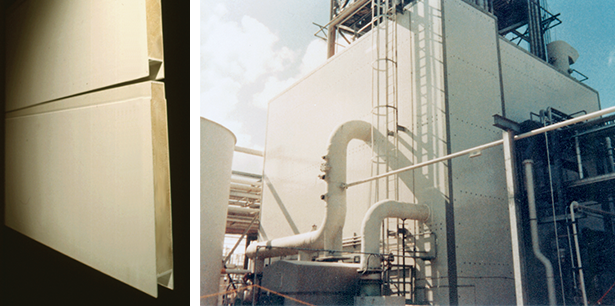Case Study: Foam Core Structure Isolates Toxic Chemical For Worker Safety
 The production of the chemical phosgene used in the manufacture of polycarbonate must be carefully monitored and controlled, because phosgene is very toxic in the gaseous state. Typically, phosgene is processed in a piping system that is unsheltered. If a leak occurs, a siren sounds and workers leave that area. Operations are shutdown until inspections are completed, which can take hours.
The production of the chemical phosgene used in the manufacture of polycarbonate must be carefully monitored and controlled, because phosgene is very toxic in the gaseous state. Typically, phosgene is processed in a piping system that is unsheltered. If a leak occurs, a siren sounds and workers leave that area. Operations are shutdown until inspections are completed, which can take hours.
Dow Chemical is leading its industry in an effort to protect workers and avoid costly shutdowns with the first attempt to completely contain the phosgene manufacturing process. A 40' x 40' x 40' fiberglass foam core building encloses the operation in an airtight environment, which contains 200 pipe penetrations. The structure passed all tests for superior performance when it went into service. Strongwell designed and fabricated the building for Dow Chemical using 3" thick x 24" wide foam core panels and EXTREN® structural shapes that provided a support system for the structure.
| TECHNICAL DATA |
|---|
| Product: Phosgene Enclosure |
| Process: Pultrusion |
Materials:
|
Sizes: DURASHIELD® Panels:
|
| User: Dow Chemical |
Foam core panels were selected over corrugated fiberglass panels because the tongue and groove assembly provides a complete seal. Additionally, the insulating characteristics of 3" foam core panels better contain possible phosgene leaks than alternative materials. To provide for pipe penetrations, holes were cut in the panels, with EXTREN® sheet, caulking and epoxy used to seal around pipes. The fiberglass foam core panel roof has walkways of DURADEK® fiberglass grating to give workers access to vessels on top of the roof.
The fiberglass pultruded foam core panels provide a corrosion resistant structure that is very strong and rigid. It was designed to withstand 140 miles per hour hurricane winds on the Texas Gulf Coast.